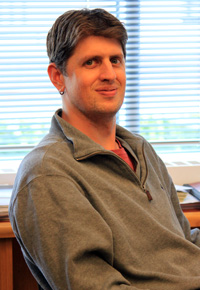
Department of Systems Biology
Harvard Medical School
200 Longwood Avenue, WAB444
Boston, MA 02115
(617) 432-6909
mario_niepel [at] hms [dot] harvard [dot] edu
Research
I am interested in studying cell type specific network responses in cancer. Due to intrinsic and extrinsic differences, cells, even those derived from the same tissue in the same organism, will show significant differences in their response to growth factors and drugs. Such variations can have important clinical implications. For examples, therapeutics should only affect diseased tissues, yet leave healthy tissues unharmed. Or, drugs that are effective on a tumor in a certain micro-environment might fail elsewhere. Understanding these differences are crucial to enable us to effectively manage and treat cancer.
To gain better understanding about cell type specific responses I am pursuing two related approaches. The model system I utilize is the EGF receptor signaling network in breast cancer cell lines.
Cell Type Specific Signaling Networks: Using both ODE models and Boolean Logic Networks I am attempting to build network models for a number of select breast cancer cell lines. Building these cell line specific models should help us understand the underlying causes of their different signaling properties. In addition, studying how these different signaling networks affect cellular responses should bring us one step closer to developing treatments that are tailored to target specific tumors more effectively.
Heterogeneity in EGF Network responses: Even in clonal cell populations, not all cells respond in exactly the same way to cues. These subtle differences can have significant consequences in the treatment of cancer. If, for example, even a small fraction of cells within a tumor remains unaffected by a specific dose of a therapeutic agent, cancer recurrence would be a likely outcome. Using single-cell measurements of both signaling events and cellular responses, we are trying to build models that will help us uncover the sources of the heterogenity within a cell population. Furthermore, we seek for ways of how such heterogeneity affects the response to growth factors and drugs. This information may help in developing treatments that reduce this heterogeneity.
Education
Postdoctoral Fellow, Systems Biology
Harvard Medical School, Department of Systems Biology
Advisor: Peter Sorger
The Rockefeller University, NY — Ph.D. in Cell Biology, 2005
Dissertation: “The Myosin-like Proteins in S. cerevisiae: Multifunctional, Structural Components of the Nuclear Envelope.”
Advisor: Mike Rout
UC Riverside, CA — M.S. in Biochemistry, 1998
Thesis: “Characterization of the Cap-independent Translational Enhancement Conferred by the 5’ Leader of the Tobacco Etch Virus.”
Advisor: Daniel Gallie
RWTH Aachen, Germany — Diplom in Molecular Biology, 1998
Thesis: “The effect of mRNA secondary structure within the 3’ UTR on translation.”
Advisor: Fritz Kreuzaler
Publications
Niepel M, Molloy KR, Williams R, Farr JC, Meinema A, Cristea IM, Chait BT, Rout MP, Strambio-De-Castillia C. The nuclear basket proteins Mlp1 and Mlp2 form a dynamic multifunctional network at the nuclear periphery. 2011 submitted
Keck JM*, Jones MH*, Wong C, Binkley J, Chen D, Jaspersen SL, Holinger EP, Xu T, Niepel M, Rout MP, Vogel J, Sidow A, Yates J, Winey M. A Cell Cycle Phosphoproteome of the Yeast Centrosome. Science. 2011 accepted
Millard BL, Niepel M, Menden MP, Muhlich JL, Sorger PK. Adaptive informatics for multi-dimensional experimental data and its application to single-cell pharmacology. Nat Meth. 2011 Apr;doi:10.1038/nmeth.1600
Chen WW*, Niepel M*, Sorger PK. Michaelis-Menten equations and representations of biochemical reactions as dynamical systems. Genes & Development. 2010 Sep;24(17):1861-1875
Strambio-De-Castillia C, Niepel M, Rout MP. The nuclear pore complex: bridging nuclear transport and gene regulation. Nature Reviews Molecular Cell Biology. 2010 Jul;11(7):490-501
Yang, R*, Niepel M*, Mitchison TK, Sorger PK. Dissecting variability in responses to cancer chemotherapy through systems pharmacology. Clinical Pharmacology and Therapeutics. 2010 Jul;88(1):34-8
Niepel M*, Spencer SL*, Sorger PK. Non-genetic cell-to-cell variability and the consequences for pharmacology. Curr Opin Chem Biol. 2009 Dec;13(5-6):556-61
Chen WW*, Schoeberl B*, Jasper PJ*, Niepel M, Nielsen UB, Lauffenburger DA, Sorger PK. Input-output behavior of ErbB signaling pathways as revealed by a mass action model trained against dynamic data. Mol Syst Biol. 2009;5:239.
Niepel M*, Strambio-de-Castillia C*, Fasolo J, Chait BT, Rout MP. The nuclear pore complex-associated protein, Mlp2p, binds to the yeast spindle pole body and promotes its efficient assembly. J Cell Biol. 2005 Jul 18;170 (2):225-35.
Gallie DR, Ling J, Niepel M, Morley SJ, Pain VM. The role of 5′-leader length, secondary structure and PABP concentration on cap and poly(A) tail function during translation in Xenopus oocytes. Nucleic Acids Res. 2000 Aug 1; 28(15):2943-53.
Niepel M, Ling J, Gallie DR. Secondary structure in the 5′-leader or 3′-untranslated region reduces protein yield but does not affect the functional interaction between the 5′-cap and the poly(A) tail. FEBS Lett. 1999 Nov 26; 462(1-2):79-84.
Niepel M, Gallie DR. Identification and characterization of the functional elements within the tobacco etch virus 5′ leader required for cap-independent translation. J Virol. 1999 Nov; 73(11):9080-8.
